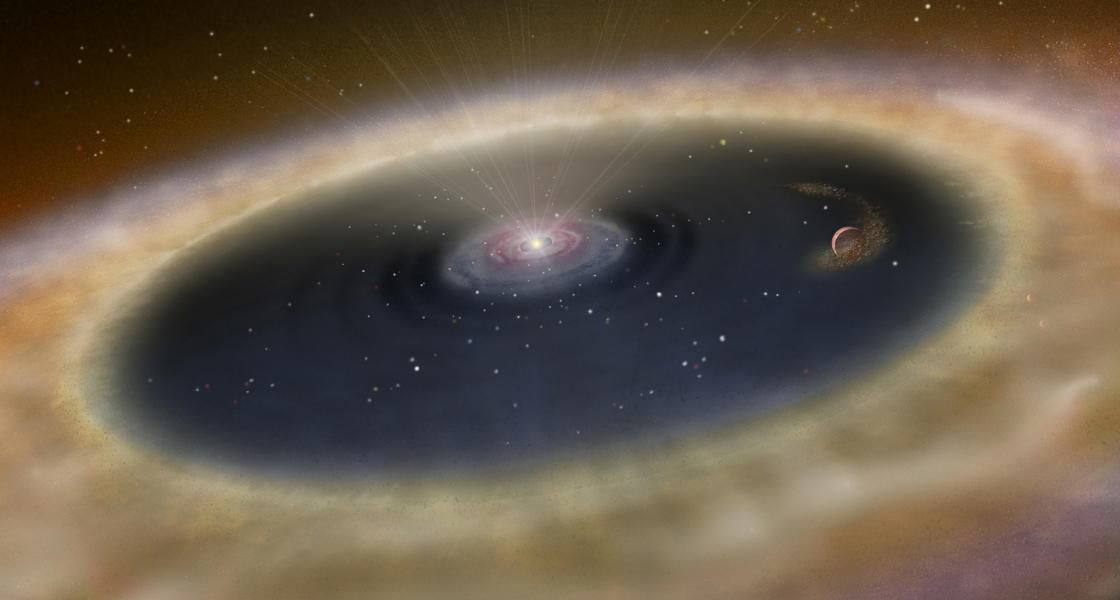Giant planets form inside a disk of gas and dust orbiting a new star. At first, gravitational interactions between the disk and the planets will keep planetary orbits circular, according to Fellow Phil Armitage. But, once the disk begins to disperse, things get very interesting.
Over millions of years, X-rays emitted by the central star evaporate the protoplanetary disk until it eventually disappears. Just before it disappears, the disk becomes thin enough that its gravitational interactions can no longer keep unstable planetary systems in check.
Once they’re freed from the grip of the disk, giant planets can turn violently unstable because they have formed rapidly and often very close together. Interactions and collisions among them can send gas and ice giants rocketing into their star, change the shape and inclination of their orbits, or knock them out of the star system. The most energetic interactions also affect the stability of rocky planets nearer to the star as well as the planetoids and debris found out beyond the planet-forming regions. In short, the violent interactions set off by disk clearing appear to be chiefly responsible for the final blueprint of a star system.
Recently Armitage and Nickolas Moeckel of Cambridge University’s Institute of Astronomy modeled planet-disk and planet-planet interactions during disk clearing and through 50 million years of planetary system evolution. They discovered that the evolution of planetary systems is complex. Sometimes, there are phases in which massive planets orbit within peculiar gaps, such as the one shown in an artist’s conception (above) of exoplanet candidate LkCa 15 b, the youngest planet ever found.LkCa 15 b was discovered with two 10-meter Keck telescopes on the Big Island of Hawaii.
Other times, giant planets will form inside the disk without gaps. And, nearly a third of systems with multiple giant planets will form stable resonant chains as the disk evaporates. These resonant chains protect the system against the most violent interactions. With fewer, if any, violent interactions, it likely that (1) most of the giant planets will survive (in orbits that remain close to circular), (2) three or four terrestrial planets (also in near circular orbits) will survive, and (3) the system will retain a large disk of dust and other debris in orbits beyond those of the giant planets.
Moeckel’s and Armitage’s new simulation sheds some light on the layout of the Solar System, with its four gas and ice giants and four terrestrial planets, all in near circular orbits. But, the new simulation doesn’t tell the whole story of the evolution of the place we call home. Fifty million years of Solar System evolution can’t account for the relatively puny debris disk (known as the Kuiper Belt) orbiting the Sun out beyond the planet Neptune.
Armitage says that the event responsible for putting the Kuiper Belt on a crash diet occurred after 700 million years of Solar System evolution. That’s when Uranus and Neptune moved out into their present orbits and interacted with the then much-larger Kuiper belt. The outward movement of the two planets hurled comets and asteroids every which way. Some flew out into space and others bombarded the Moon, Earth, Mars, and the moons of the giant planets.
This kind of late bombardment, which resulted in the Kuiper Belt becoming a mere shadow of its former self, actually appears to be quite rare. In earlier work, Armitage showed that the presence of a large outer disk of dust and debris in a star system is predictive of the presence of inner rocky planets like our Earth. — Julie Phillips




